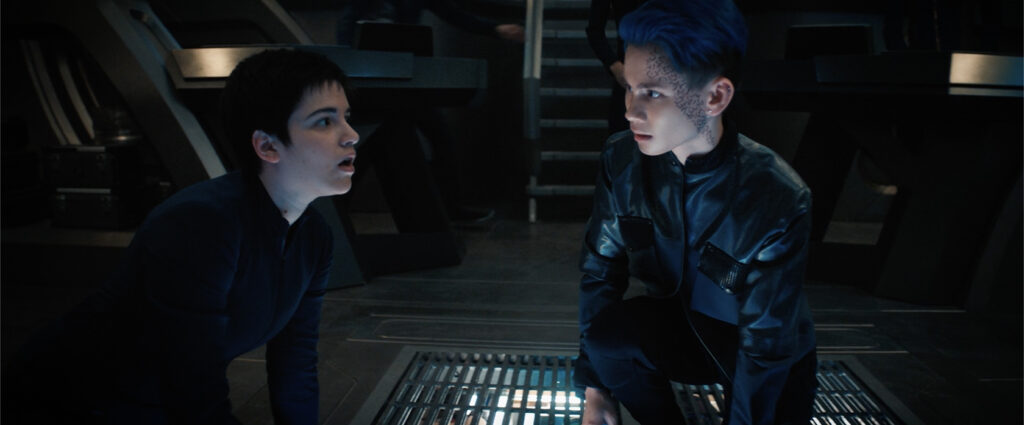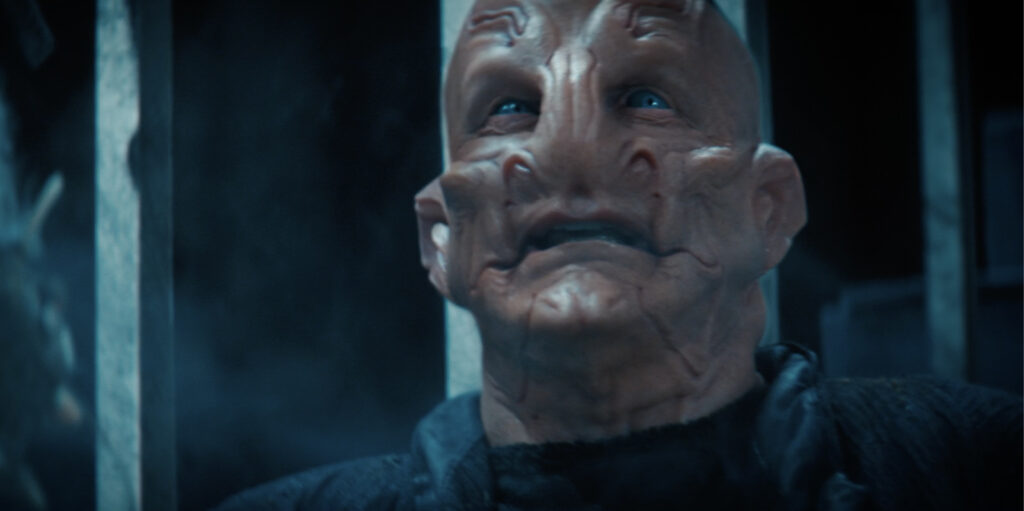LET’S END THE YEAR WITH…SPOILERS!
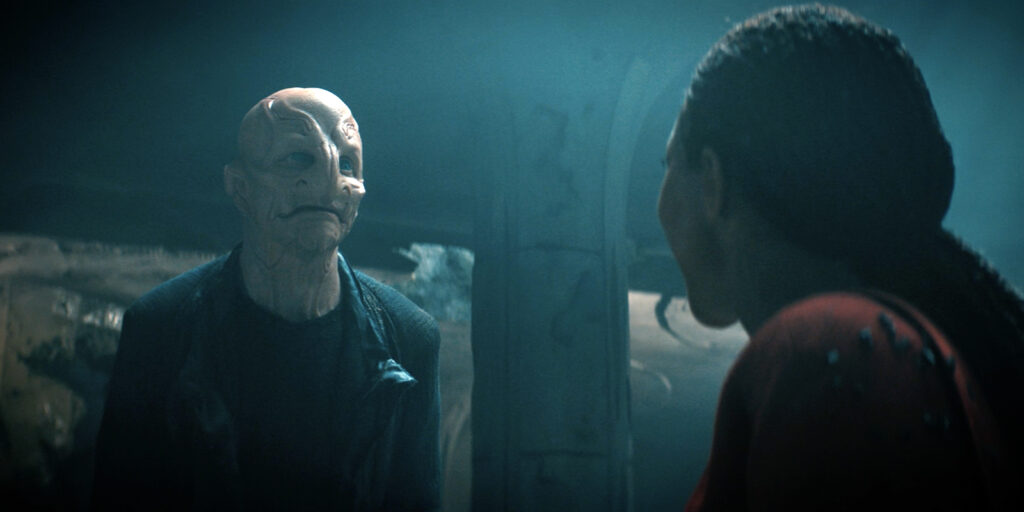
I’ve often (often!) wondered would STAR TREK: DISCOVERY would be like if it were more like the classic Star Trek I grew up with on TOS and even TNG. I’m not talking a total homage like The Orville (where the heck IS that show anyway???) but more simply carrying through on certain story elements, structure, character interplay and development, and just the overall “feel” like they used to have in the “good ol’ days.”
For what seemed like one of the only times in the three seasons of Discovery, this episode FELT like Star Trek to me. But what does that even mean “felt” like Star Trek? It seems like such a subjective and ambiguous thing, possibly different in the mind of each Trek fan watching.
So let me tell you why I personally thought that the 11th episode of season three, “Su’kal,” felt more like real Star Trek than Discovery usually does. And along the way, I’ll try to decide if this was a good or bad episode…or both! (Knowing me, it’ll probably have aspects of both—as I seem to have difficulty committing to either loving or hating the episodes this season.)
Okay, let’s do this thing…
MOVING TO MORE MODERATE AMOUNTS OF MICHAEL
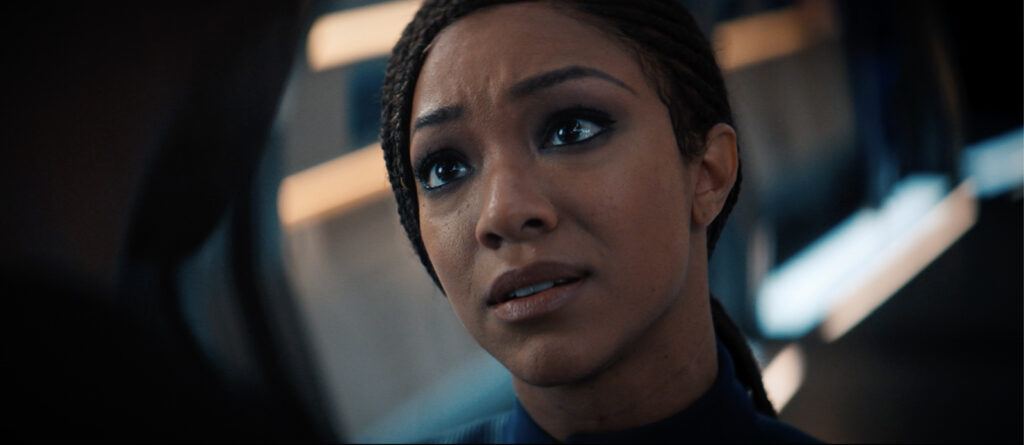
Fans couldn’t help but notice that, for the past nearly-three seasons, Discovery has felt like “The Michael Burnham Show, starring Michael Burnham as Michael Burnham.” Michael seems to be in almost every scene, usually is the center of attention, and she saves the day regularly.
One of the reasons that Star Trek‘s previous iterations worked so well is because they had a variety different characters spotlighted in different episodes. Not every TOS story was about Kirk, not every TNG about Picard nor every DS9 about Sisko nor Voyager about Janeway. There were Spock and McCoy-focused episodes, Data and Worf and Crusher episodes, Kirk and Odo and Bashir episodes, Tuvok and Paris and B’Elanna episodes, T’Pol and Malcolm and Phlox episodes…you get the idea. And just because one character was featured prominently in a story didn’t mean we wouldn’t see the rest of the crew. A Riker episode would also show the rest of the crew. Mix and match! These shows had great casts, and the captain didn’t need to be in every scene.
This episode of Discovery was the first time in a while that Michael wasn’t dead center of the action almost all the time. Excitement was also happening on the ship, and because the landing party beams down and splits up, Michael is only part of the story on the planet. Michael definitely gets some major stuff to do, but so do Saru and Culber…giving each of their characters some breathing space. On the ship, we see some great moments for Stamets, Tilly, and Adira (and one single line from Reno…really?).
In short, my friends, this episode had BALANCE. It wasn’t all Michael, all the time…or even most of the time. Yay!
Now, that said, I did find myself going WTF and laughing when Michael had this snippet of conversation with Book…
Pot, meet kettle. Michael, when it comes to not being objective, Michael Burnham could write a doctoral dissertation!
But I digress (often!)…
DISCOVERY‘S FIRST HOLODECK EPISODE
It happens to every Star Trek series (okay, not TOS…although there was that one animated episode: “Practical Joker”): the writers get what they think is a really cool idea for the holodeck to either break or behave unexpectedly in some way. Sometimes a program will gain self-awareness or threaten the ship. Maybe a hologram opens a Las Vegas night club and the crew members inside forget who they really are. Maybe you use a holodeck (or holoship) to rescue and transport pre-warp aliens from a doomed planet without violating the prime directive. Maybe there’s a planet whose people are all holograms! Maybe there’s a sentient medical hologram or predator aliens turn the entire ship into a holodeck to hunt the crew. The possibilities are seemingly endless—so much so that fans have wondered if there’s possibly any original holodeck ideas left at all!
Well, the Discovery writers somehow managed to find one. Granted, there were some elements that seemed déjà vu-ish, like holograms breaking down after a long use or an entire ship being a holodeck. But there were also some inspiringly fresh ideas like using the holodeck to raise a child, educate him, and keep him alive until rescue could arrive…and needing to “impersonate” a hologram in order to gain the trust of the lone survivor living inside the simulation.
In order for a holodeck story to work, something about it needs to make audiences say, “That’s really cool!” This episode had that.
However, this episode also made a couple of sloppy-writing blunders. These didn’t ruin the episode for me (they were just annoying), but they all stemmed from the writers needing to solve one notable challenge: getting DOUG JONES out of his Saru make-up for an episode. And I applaud them for that. This was, more than any other Discovery episode so far, a Saru episode. And Doug Jones is such an amazing actor (certainly one of the best if not the best on the series) that forcing him to give such an intense and dramatic performance this episode through that massive latex head piece is almost criminal. So let’s turn Saru into a human for one episode and let him really show his acting chops…and lord knows he did! Just watch this brief scene and marvel at all of Doug Jones’ incredible facial expressions…
But to explain it, the writers decided that the reason would be because showing Michael and Hugh as humans and Saru as a Kelpien might confuse or frighten the child. Why? Remember, Su’kal (the kid) is a Kelpien, and there’s a Kelpien elder reading him stories. So he’s seen Kelpiens before.
As for turning Dr. Hugh into a Bajoran and Michael into a Trill—because they’re human—then turning Saru into a human? Why not just leave Michael or Hugh human and make Saru the Trill or Bajoran and save a little holo-energy? That whole explanation just didn’t make sense. Also, since I just gotta nitpick, why did Saru say that his heels were touching the ground? The holoeck can’t change their anatomy, only the way they appear to others. Saru should still have felt his hooves, folks.
But hey, minor thing. Points still awarded for cool holodeck idea.
TILLY TESTED
We all knew this has to happen eventually—Tilly in the center seat—so the only real question is: how did they (the writers) do? My answer: it could have been worse, so won’t complain too much.
Okay, let’s break this down. There’s a decent lead in to the moment that Tilly takes the conn, and it involves one of Michael Burnham’s patented pep talks along with a supportive hug. I’ve always felt there should be more hugging in Star Trek…well, no I haven’t. But Discovery is now a huggy ship, and I’ve decided to just go with it. Remember when Michael first came on board in season one and everyone was so mean to her (and sometimes to each other)? I prefer the hugs; I m just a hugger.
Once on the bridge, we had a situation that we’ve seen a few times before: Troi is the highest ranking officer on the bridge during a ship-wide disaster and doesn’t know what to do, or the EMH has to pretend to be the Emergency Command Hologram and struggles to pull off the ruse. So now it’s Tilly’s turn to prove herself.
And of course, it’s not gonna be smooth sailing—she’s gets a gosh-darn (not words that Tilly would use) no-win scenario: do you wait around and risk the ship being captured or jump away, leaving and captain and landing party in lethal jeopardy?
Now, once the Kobayshi Maru starts unfolding, things get a little cringe-worthy at times. The “battle of wits” between Osyraa and Tilly felt more like something we’d have seen on Cobra Kai in some teenage mean-girl scene. Tilly tried to hold her own, but when you attempt to use Sigmund Freud to say, “I’m rubber and you’re glue, whatever you say bounces off me and sticks to you…” well, you’ve probably already lost. The fact that Osyraa even reacts at all to any of Tilly’s counter-taunts might feel good to us viewers rooting for Tilly, but really, is it at all believable? Osyraa is the equivalent of a mafia godfather like Don Corleone or Tony Soprano (only green and female). You don’t get to be where Osyraa is and still be affected by taunts from the under-qualified first officer of a 1,000 year old ship.
Of course, I do have to give props to MARY WISEMAN for pulling off the interchange and making us all believe that Tilly was doing her best not to crap her shiny blue pants while trying to sound tough. That could not have been an easy scene to master convincingly, and Mary pulled it off with flair. And when she threatened to blow up the ship, I kinda believed her. I’m still really not sure whether or not it was a bluff.
Speaking of threatening to blow up the ship, I always award bonus points when the writers cover a plot point that my mind starts thinking of. For example, just as I was thinking to myself, “If it were Kirk or Picard, he’d probably threaten to self-destruct the ship rather than let it be captured.” And lo and behold, Tilly does the same. Also, when Osyraa’s ship first approaches, I was asking to myself, “How the heck did they get there so fast??? It’s taking Starfleet weeks or months to get anywhere, and they have dilithium. But then we hear that there’s a transwarp tunnel nearby, but those are really dangerous. Okay, that explains both how Osyraa got there so fast and also why Starfleet can’t do the same if you send a distress call. Well played, writers, well played.
Oh, and finally, Discovery has a cloaking device? Convenient, I suppose…although kinda out of left field. But it makes sense that cloaking devices are common now that there’s no more need for a treaty with the Romulans. And hey, the only other way to hide would have been deeper in the nebula storm, and that wouldn’t have worked.
WHAT MAKES A GOOD STAR TREK VILLAIN?
As long as we’re on the subject of Osyraa, I’d like to say that, unlike her first appearance, this time she felt like a solid Star Trek villain—not that Star Trek always needs a villain, mind you.
But what makes someone a good bad-guy…dramatically, that is? Well, here’s my list of some of Trek‘s most compelling bad guys: Kor, Khan (both TV and movie version), Lore, Kivas Fajo from “The Most Toys,” Sela, Gul Dukat, and the Borg Queen. Now let’s examine why they work so well…
The way I see it, a villain needs to have three things to be really hateful: sadistic intentions, the upper hand, and arrogance—(over)confident in the certainty that they can and will win, relishing the inevitability of their victory, and most of all, gloating with sinister satisfaction over their helpless adversary. Mercy isn’t an option, and any that would be offered would be suspect anyway. The best villain(s) of any franchise—from Bond to Star Wars to Harry Potter—usually share those intrinsic qualities.
This is why Trek villains like Dr. Soran and Michael Eddington (not really malevolent), Ru’afo from Insurrection or Admiral Marcus from Into Darkness (not really gloating), Nero (not really relishing his victory), and Shinzon (too weak to effectively gloat) didn’t work as well as villains.
And in her first appearance, Osyraa didn’t really check all of the good villain boxes. But this time she did, and that felt satisfying. I really don’t like her, and I want her to lose—and that’s why her win in capturing Discovery makes for such a great cliff-hanger. That said, raise your hand if you think the capture was too easy. I can understand that future transporters might be able to beam through shields, but doesn’t Discovery at least have an “Intruder Alert!” alarm? And if not, do you expect us to believe that no one in engineering was able to hit their comm badge in time to warn the bridge about what was going on? Yeah, I know Osyraa had to take over the ship quickly because the episode was running out of time, but it just seemed TOO easy. I don’t blame Tilly for Discovery‘s getting captured, but I do blame the writers.
A GENERALLY STRONG EPISODE WITH TWO MINOR MISFIRES
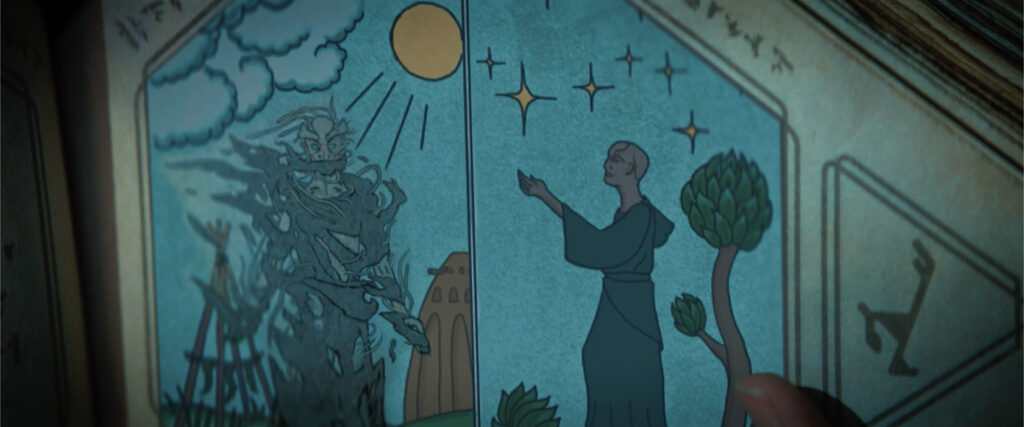
Overall, I really did enjoy this episode. It was one of the strongest of the season so far, and Canadian director NORMA BAILEY (on her first outing directing for Discovery) did an excellent job with structure and pacing and overall look of the sets and the lighting…as well as getting some really top-notch performances. This wasn’t easy to do considering how many plot threads need to be wrapped up in these final three (now two) episodes. In fact, the “Previously on Star Trek: Discovery” spent just a sliver under TWO MINUTES recapping everything we needed to be reminded of going into this episode. Juggling so many plot lines and still keeping the pacing and interest of the viewer would normally be a huge challenge.
But there were two aspects of this VERY full episode that left me less than satisfied. The first was “Gray ghost” suddenly reappearing after being MIA for a few episodes and pretty much just saying, “I was afraid to come out.” Um…okay. As much as I like Adira and Gray as characters, I don’t really care that much about Gray just yet to truly feel his pain. I’m hoping (and assuming) that more will happen with Gray either this season or next. I want to care about him more, I just don’t yet.
Oh, and there’s an unexpected problem that has arisen in referring to Adira as “they.” I understand and appreciate the whole non-binary thing. I respect people who live without conforming to one gender. But because of Gray, I now have to mentally stop whenever I hear someone on the show say “they” when referring to Adira and try to figure out if the pronoun is referring to just Adira or to both Adira and Gray together. Not sure there’s a fix, but it’s getting noticeably irksome the more it happens.
And finally, the Burn was caused by a traumatized child??? On the one hand, I wasn’t expecting that, so props for surprising me…and probably most other fans, too. But I feel like we’ve just gotten another “red matter” plot device. In Star Trek 2009, a tiny drop of red matter can create a black hole, and yet, it can also be mined and transported. There’s a LOT of science to ignore and overlook in that. Granted, Star Trek does a lot of things that science doesn’t allow: beaming, traveling faster than light, instant communication across hundreds of light-years, artificial gravity. But red matter was a biggie…and so is Su’kal, the kid whose emotional cry can destabilize and destroy nearly all of the dilithium in the galaxy (possibly beyond).
I certainly get the dramatic implications of this. The kid is innocent and unaware that he’s a living doomsday machine. But even so, this is one of those “needs of the many” situations where, if you can’t keep him calm or drugged or get him away from the planet or neutralize his abilities, then set phaser to “vaporize” and save the galaxy. But that’s not what the good guys do. I get it. But man, I just have all kinds of trouble accepting that a single kid raised on a dilithium planet surrounded by strange radiation is the perfect set of ingredients for something like the Burn. That’s more suited to a superhero origin story than a respected sci-fi tentpole like Star Trek. I mean, I guess I have to accept it, but it just feels somehow underwhelming and anti-climactic.
Like the end of this blog.





